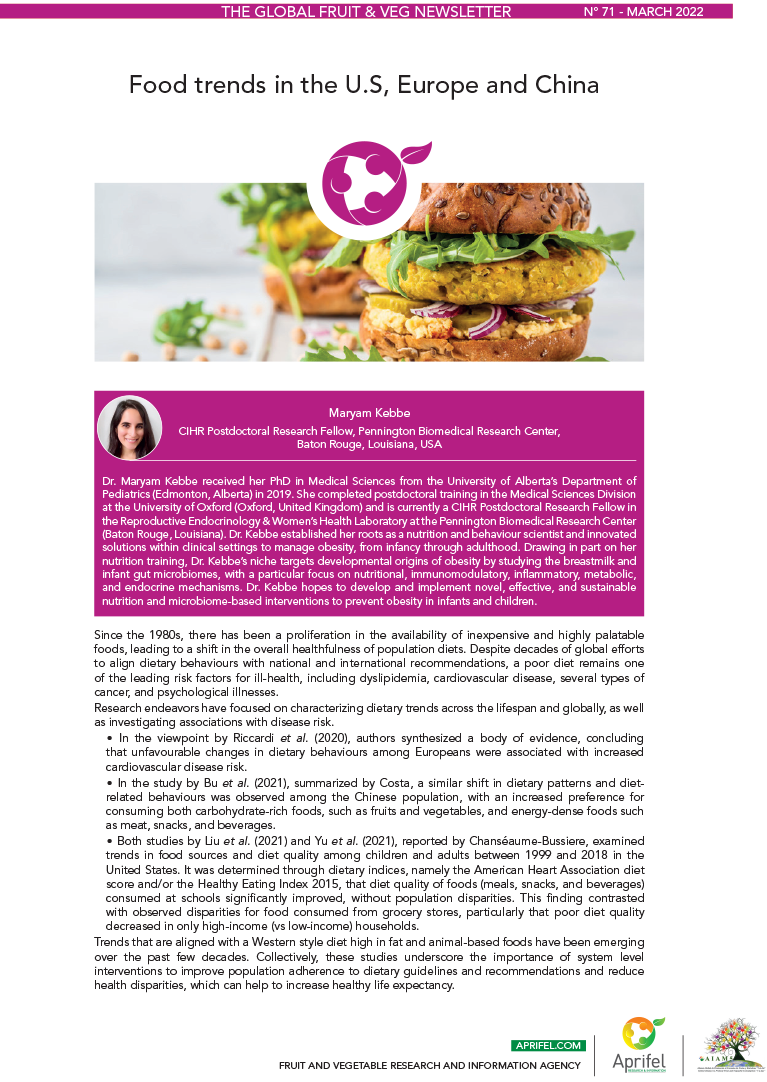Dietary habits and their impact in cardiovascular diseases : a viewpoint on trends in Europe

Cardiovascular diseases (CVD) are a global burden: they are the main cause of deaths in Europe with 45 % of all deaths (i.e, 4 million deaths by year) (Wilkins et al, 2017).
In 2016, more than 9.1 million premature deaths from CVD worldwide are attributable to diet-related risks (52% of all CVD deaths). In Europe, 2.1 million diet-related CVD deaths were reported in 2019. This highlights the key role of dietary patterns and food choices and the need to be optimized for health and well-being (GBD 2017, Meier 2019).
The aim of this viewpoint is to evaluate food choices of the European population and their temporal trends in relation to possible effects on the CVD risk.
Cardiovascular diseases : trends, change and progression
CVD mortality rates were highest at the beginning of the 21st century, with the greatest increases in Central and Eastern regions, and are now declining while remaining the leading cause of death in Europe. This is partly due to the prevention and treatment of the disease, and we observe downward trends in certain risk factors (alcohol consumption, smoking, hypercholesterolemia, etc.). On the other hand, other risk factors, in particular overweight/obesity and diabetes, have increased by over 50% and 25% respectively during the last 10 years (Wilkins et al, 2017).
Diet : a major contributor to cardiovascular diseases
Food choices are the most important factors undermining health and well-being, for as much as almost 50% of all CVD deaths. Research on the relationship between diet and cardiovascular health shows that excessive intake of energy, saturated fat, trans fat, sugar and salt, as well as a low consumption of vegetables, fruits, nuts and wholegrain are leading lifestyle-related cardiovascular risk factors and major reasons for concerns. Among them, food choices associated with the strongest relationship with CVD are low intakes of wholegrain, nuts and seeds, and fruit and an excessive salt consumption (cf. Table 1).

Trends of dietary habits in Europe
In 2000, WHO and FAO organized a Joint Expert Consultation on Diet, Nutrition and the Prevention of Chronic Diseases, to undertake more effective and sustainable policies and strategies to deal with the increasing public health challenges related to diet and health (WHO/FAO, 2003). However, in the last decade, the trends of dietary habits in Europe are not reassuring, as only minor changes occurred, with shifts leading to unhealthy choices in some cases, thus interrupting the favorable trends observed up to the beginning of the new century (figure 1).
- Fruit and vegetables: over the past 60 years, fruit consumption has increased substantially across Europe, in parallel with that of vegetables (availability of fruit and vegetable, respectively 30% and 20%; however, a slow decline has occurred in the last decade.
- Wholegrain: the consumption is rather low, except for Northern countries. Despite a trend towards a greater intake in many European countries, it remains well below the recommended target of 50% of total cereal food consumption.
- Energy and fat: the increase has begun already in the second half of the last century; a small decline has appeared in the last decade.
- Salt and free sugars: the consumption still exceeds the intake recommended by WHO (5 g salt/day and 5 to 10% energy for free sugars). Manufactured foods (baked goods, breakfast cereals, sugary drinks…) brought a significant proportion of free sugars.

Dietary habits in Europe have shifted away from a healthy dietary pattern
These data clearly show that dietary habits have drifted away from a healthy dietary pattern all over Europe. Mediterranean countries are particularly facing this trend because of the “westernization” of their habitual diet following the process of globalization of food production and distribution, but also due to the increasing cost of many food items typical of the Mediterranean diet. This facilitates a shift towards less expensive, energy-dense foods with typically lower nutritional quality.
Based on : Riccardi G, Vitale M, Vaccaro O. Are Europeans moving towards dietary habits more suitable for reducing cardiovascular disease risk? Nutr Metab Cardiovasc Dis. 2020 Oct 30;30(11):1857-1860. doi: 10.1016/j.numecd.2020.07.018. Epub 2020 Jul 23. PMID: 32912794.
- A balanced diet rich in fruit, vegetables, wholegrains, nuts, and seeds, and low in salt and free sugars is a potential key lever to reduce cardiovascular risk.
- Policies to increase consumption of vegetables, fruits, and whole grains, are needed to prevent cardiovascular disease.
- There is urgent need for an appropriate strategy to improve the nutrition skills of health professionals, particularly in primary care.
- Policy options should necessarily include initiatives to facilitate production, marketing, availability, and affordability of healthy foods in each and every European country.

